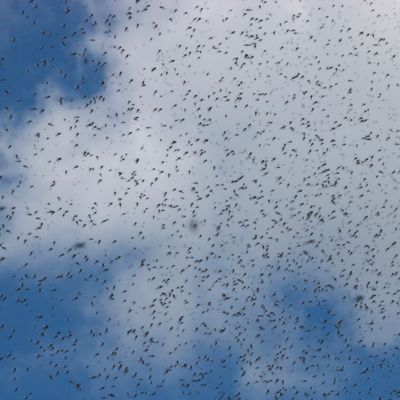
There is nothing like a new insect crisis to remind us all that we are rapidly coasting into end-times without any brakes to speak of. One month into summer, 2023’s “It” bugs have arrived: millions of minuscule gnatlike creatures, which have descended on New York City seemingly from nowhere in thick clouds that scream “plague.” People are once again panicking, the city is under siege, and I am thinking it might be time to pack it all in and hand control of Planet Earth over to the invertebrates. Clearly, they are already in charge here:
While plenty of New Yorkers have (correctly, in my opinion) identified the city’s newest residents as yet another of God’s smitings, there may be a couple more “science-y” explanations for their arrival. Gothamist wonders if the visitors might be some kind of “fire-loving” bug, of which there are apparently many. These tiny flame maniacs, known formally as pyrophilous insects, include species like smoke flies and fire beetles. They have been known to congregate at forest fires, where they reproduce in the charred air — sexy, I know. Given the wildfire-fueled haze that recently overtook the city, it’s possible some of these horny pyros might have heard the siren call of air pollution and packed their bags to live large in the Big Apple.
Another theory posits that the bugs are ash aphids, which are harmless but annoying little guys who’ve been congregating in areas of the West Coast for years. Although the arson-adjacent name makes them sound like the harbinger of biblical doom, it merely evokes the color of their wings. Last year, during a particularly bad invasion, residents of Spokane, Washington, were advised to “try not to breathe too deeply,” something I’ve been doing anyway for reasons unrelated to bugs.
Surprisingly, local experts seem largely unconcerned about the gnat swarms or whatever they are. Speaking to our colleagues at Curbed, an entomologist IDed them as aphids, which are small insects that feed on plant sap. (As such, they have what one professor called “sucking mouthparts” and are of course related to the infamous spotted lanternfly.) David Grimaldi, a curator and entomologist at the American Museum of Natural History, claimed in an interview with The City that we should take our guests as signs of a “healthy environment.” He went so far as to say he was impressed by “the emergence of winged morphs,” because it means we have fewer pesticides in the air. And Jody Gangloff-Kaufmann, a pest scholar at Cornell, deduced that the soupy weather we’ve been enjoying of late “triggered a mass migration of winged aphids,” which is apparently somewhat unusual — aphids only give birth to winged offspring when their population size gets overwhelmingly large. Still, Gangloff-Kaufmann predicted that their presence — and the widespread agitation it has set off — will likely “stop as quickly as it started.”
Nonetheless, we can probably expect to spend our July Fourth weekend taking shallow breaths and picking bugs off our popsicles. Happy holidays to all!


